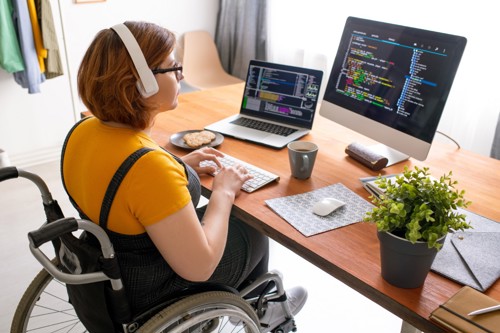Covid-19: Understanding stress responses

As the world continues to adjust to the ongoing coronavirus pandemic, Andy Caress discusses how the Covid-19 situation can impact our stress responses.
Every person has been affected differently by the events of the past year and, for many of us, we’ve been confronted with new forms of stress that we were not prepared for. This informative video explores how these new-found stresses can cause completely different reactions, beyond the fight or flight response. It looks at the various sources of pressure and provides helpful guidance to build and maintain a wellbeing toolkit for the future.
We hope you can find the time to watch the full webinar. If not, we’ve summarised the key parts below for you.

How are you coping today? (02:53)
The Covid-19 pandemic has had a significant impact on us all mentally. Each and every one of us has been impacted by the lockdown and the many social restrictions in different ways. This unsettling period has underscored the importance of looking after both our physical health and mental wellbeing – but it has also been a very stressful time to endure.
It’s always a worthwhile exercise, whatever your personal circumstances, to ask: "how am I coping today?” The Blob Tree is a recommended and widely-used tool for self-reflection and to express feelings and issues; it’s a way to explore anxiety, loneliness and a range of difficult emotions that may well have emerged during these unprecedented times.
What do we mean by mental health? (04:09)
The World Health Organisation (WHO) defines mental health in a positive way – as a state of wellbeing in which every individual realises his or her own potential, can cope with the normal stresses of life, can work productively and fruitfully, and is able to make a contribution to her or his community.
Throughout the course of this pandemic, many people have expressed concern and guilt that they are not feeling productive or that they are letting themselves or others down by not making more of a contribution to their organisations and communities. It’s vital to remember that, while some have responded to the challenge of the pandemic admirably, this is not a normal stress of life!
Coronavirus has presented us all with such a unique situation, beyond what any of us are used to coping with. The ability to be productive or fruitful has almost been suspended for many people, and that is OK. This has not a position that any of us were prepared for.
Stress during lockdown (05:56)
Stress, as a general rule, is a good thing: if we do not feel and experience stress, then we are likely under-stimulated and will become unmotivated. Whether it's preparing for exams or working hard to earn money, we need stress in our lives to provide us with the steer and drive to move forwards towards our goals.
The desire to want to personally achieve and to help others nudges us towards action. Yet when stress levels become too high, this can lead to an excess of anxiety and feelings of being overwhelmed, distressed and dysfunctional.
The Covid-19 pandemic has led to feelings of overwhelming stress for many people – and it’s important to consider and question why this has been the case. The health ramifications and fear of becoming ill, while the most obvious concern, is not necessarily what has been at the forefront of the minds of many. It may be the absence of friends and family, the lack (or cancellation) of experiences to look forward to, uncertainty about the future or – likely – a combination of all of these concerns. If you are finding the situation to be overwhelming, it’s worth taking the time to ask yourself: why?
Sources of pressure as a result of the pandemic (07:24)
Stressors vary from person to person, yet there have been a number of pressure sources that many of us have felt throughout the course of the pandemic, including:
- Financial stress: Being removed from your source of income is a significant stressor, and Government support has not been available to everyone. Financial stress has weighed heavily on many people’s minds during this time.
- Social isolation: Some people thrive by themselves; many have really struggled as a result of being cut off from their usual social interactions and support networks.
- Health issues: For those people with an underlying health issue, the pandemic has presented an ongoing concern of being in an “at risk” group and what this could mean.
- Sense of entrapment: While some in the UK are lucky enough to have access to green spaces and nature, others in more urban environments – or just because of a personal situation – may find themselves feeling ‘trapped’ in an environment or situation that is uncomfortable or even dangerous.
- Unsafe home environment: Rates of domestic violence and child abuse have unfortunately increased during the course of the lockdowns; this is a deeply concerning area that we must recognise and treat sensitively.
- Lack of accurate or trustworthy information: Trust has been a big issue throughout Covid-19; there remains a sense of not knowing who to trust or where to turn for accurate, helpful information and advice.
- Fears about vulnerable family/friends: We all know someone who has been especially vulnerable during this time; this can lead to feelings of helplessness and deep concern, being unable to do anything to actively 'help’ those we are close to.
A news article exploring pandemic personality types during the first national lockdown claimed that Brits fell into three categories: sufferers, accepters and resistors. A King's College London spokesperson said at the time that "the large bulk of the population are fully behind the measures, but even within this group there are clear dividing lines between those who are coping pretty well and those who are really suffering.” This situation is unquestionably difficult, and some people will struggle in different ways to others.
‘The Amygdala Hijack’ considers our response to overwhelming situations: under normal circumstances, we process information through the neocortex or “thinking brain” where all higher functioning – logic, problem solving, prioritising – occurs. But when we are under severe pressure, the brain may panic and activate the alarm system which hijacks some of our higher cognitive functions; this puts us into survival and reactive mode. Threat raises both our psychological and physical defence levels; hard-wired into us all is the body’s desire to both evaluate and reduce stress while also maximising our chances for survival.
The Six Fs of stress response (12:16)
Our brains and our bodies will put psychological and physical defences into action in order to protect us from perceived harm or danger – this is typically presented in one, or more, of the Six Fs:
- Fight: The urge to take back some sense of control or to fight against a perceived cause of stress and be liberated: around the world, a number of anti-lockdown protests have now taken place, with individuals refusing to comply with social distancing measures and restrictions despite the associated health risks.
- Flight: Many people removed themselves from bustling city environments, especially around the first lockdown, moving towards more rural areas. This has resulted in an understandable ‘kickback’ from some of these communities. Human beings are not alone in being tempted to flee a harmful situation: in the animal kingdom, active defensive responses turn to passive freezing when active responses are likely to threaten survival. For both humans and animals, when active defences are impossible or ill advised, they may be replaced by passive defences such as submission, automatic obedience, and freezing (Nijenhuis & Vander Hart, 1999).
- Freeze: If fighting back doesn’t appeal and flight is impossible, some people will ‘freeze’, shut down and stop functioning in some way. Staying home, not engaging with the wider world and withdrawing are all associated with the 'freeze' stress response.
- Flop: A 2020 news article exploring lockdown fatigue found that many people felt tired and lacking motivation during the first months of the pandemic. A sense of apathy and a lack of purpose crept in for many, and remains.
- Friend: The pandemic has shown that it is possible to actually "befriend” a source of stress, with some treating the lockdown a bit like a holiday and choosing not to confront the wider issue, instead pretending it is not real: this can create a feeling of control. Befriending may also occur within unsafe home environments, with dangerous individuals pacified by those that are living with them in fear.
- Flock: Over the course of the pandemic, countless examples of people’s desire to be close to one another – physically or socially – have been seen, from clapping for our carers to displaying colourful rainbows in our windows. All of these are ways to engage with the ‘flock’, even at a time when social distancing has become the temporary norm. Feeling less alone can be a powerful tool in the battle against social isolation.
The restrictions that have been put in place to prevent the spread of coronavirus mean that most of us will be forced to resort to more passive defence measures – freeze, flop, friend and flock. For some of us, this will be a positive; for others, this is challenging. Viewing our current behaviours through the lens of the ‘Six Fs’ is a way of understanding how we are coping with this situation – and why.
Building a Wellbeing Toolkit (21:16)
American psychologist Abraham Maslow is well-known for his 'Hierarchy of Needs’ that prioritises our innate human needs. He is famously quoted as saying that “it is tempting, if the only tool you have is a hammer, to treat everything as it if were a nail.” In other words, if you only have one way of coping (such as exercise) and this is taken away from you, then you may fight against a situation rather than working around it.
Building up a wellbeing toolkit is hugely important for us all – this will differ from person to person, but everyone can benefit from understanding the ‘tools’ that aid and support positive mental health and wellbeing. Examples can include:
- Apps: There are many apps readily available in the marketplace, from Breethe to Calm to Headspace, that are designed to help encourage positive wellbeing.
- Journaling or mindful colouring: Taking time to be mindful and think critically can help to overcome overwhelming feelings. Undertaking creative and self-reflective activities can have big self-help benefits; many resources are available online to help young people in particular.
- Working from home: Working remotely, and home schooling, can be immensely challenging currently. It’s important to acknowledge that this is an ‘out of the ordinary’ situation and to find time for ourselves throughout it. Our Working from Home wellbeing action plan provides support and advice for those who are working from home during this time.
- STOPP method - This self-help method can be an invaluable way to practice self-care and perspective, encouraging time to be taken to stop, breathe, observe, pull back and practice what works at an individual level.
- 5 ways to wellbeing – #5aDayWellbeing encourages us to take small steps each and every day: to connect, be active, keep learning, give and take notice. Incorporating small positive changes, both individually and as families, can help to weather stormy seas and uncertain times.
- The Worry Tree – This self-help tool helps with understanding where worry comes from and if the situation can be controlled. It encourages focus to be placed on what is within our control and activating the thinking parts of our brain, rather than being so reliant on the Amygdala.
Stress levels will fluctuate and feel overwhelming at times during the course of this pandemic, and possibly beyond as we all deal with the experience we have endured and adjust to the ‘new normal’. Yet there is no need to compare ourselves with how others are coping with or responding to the situation. All any of us can do is cope in the best way that we possibly can ourselves. We can do this by celebrating the little victories we achieve each day and putting wellness measures and positive steps in place, identifying when our stress levels are rising and finding the space, time and tools to become calm once more.
Resources
Was this article helpful?
Your feedback helps us create better content so if this article helped, please leave a like below and let others know.
The Charlie Waller Trust
The Charlie Waller Trust is a registered charity in England and Wales 1109984. A company limited by guarantee. Registered company in England and Wales 5447902. Registered address: The Charlie Waller Trust, First Floor, 23 Kingfisher Court, Newbury, Berkshire, RG14 5SJ.
Copyright © 2025 The Charlie Waller Trust. All rights reserved.




